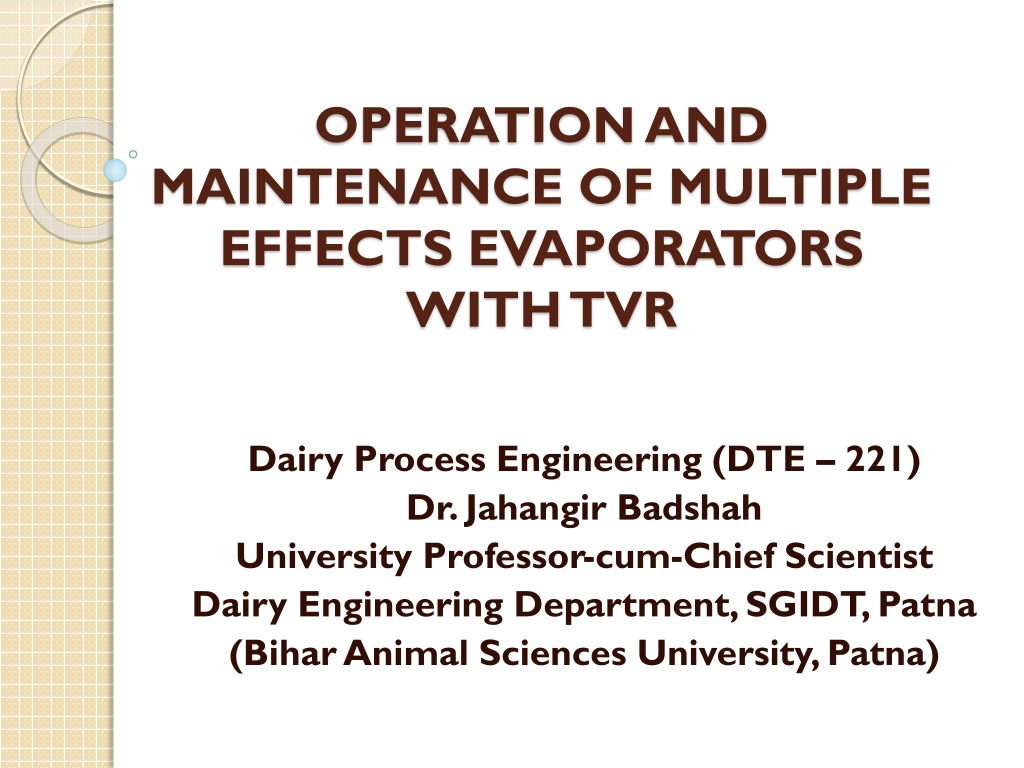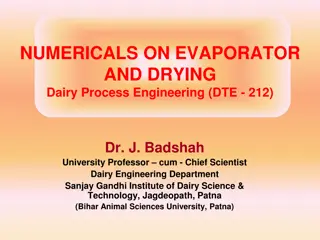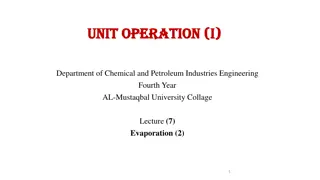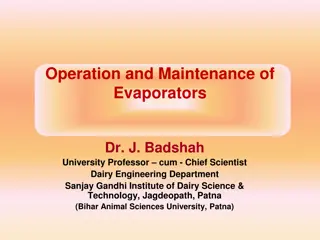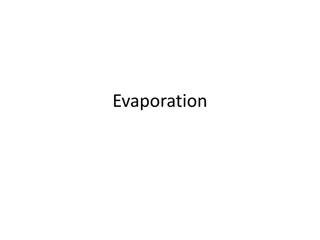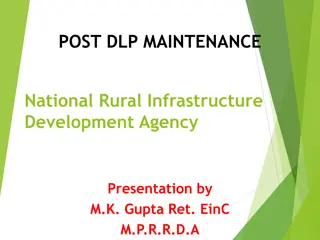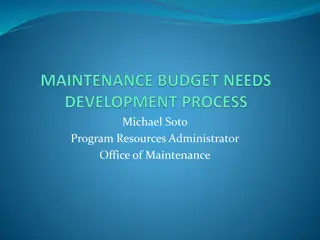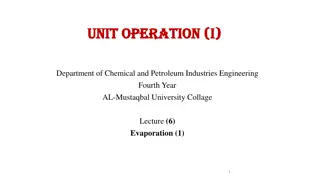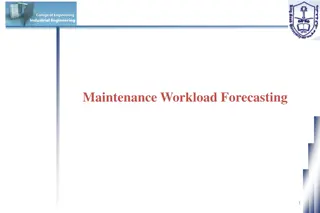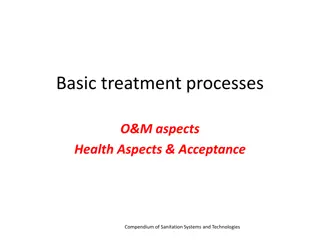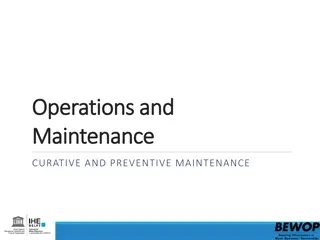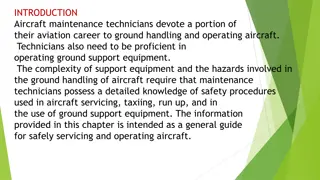Operation and Maintenance of Multiple Effects Evaporators with TVR
Preparations required for the operation and maintenance of multiple effects evaporators include ensuring the availability of utilities like electricity, water, compressed air, and steam at the required pressure. Proper maintenance steps such as vacuum tests, checking for leakages, and conducting air leakage tests are essential in maintaining the efficiency of the evaporating plant. Additionally, procedures for water and steam leakage tests are outlined to prevent any issues during operation.
Download Presentation

Please find below an Image/Link to download the presentation.
The content on the website is provided AS IS for your information and personal use only. It may not be sold, licensed, or shared on other websites without obtaining consent from the author. Download presentation by click this link. If you encounter any issues during the download, it is possible that the publisher has removed the file from their server.
E N D
Presentation Transcript
OPERATION AND MAINTENANCE OF MULTIPLE EFFECTS EVAPORATORS WITH TVR Dairy Process Engineering (DTE 221) Dr. Jahangir Badshah University Professor-cum-Chief Scientist Dairy Engineering Department, SGIDT, Patna (Bihar Animal Sciences University, Patna)
PREPARATIONS REQUIRED UTILITIESAND SERVICES REQUIRED ELECTRICITY WATER COMPRESSEDAIR STEAMAT REQUIRED PRESSUREAS PER CAPACITY SPRAY POND WITH PUMPS FOR SUPPLY OF WATER TO CONDENSOR CLEANING & SANITIZATION OF EVAPORATING PLANT PROPER SETTING AND CLOSING OF VAPOUR SEPARATORS WITH GASKETS PROPER SS PIPE LINES TIGHTENING WITH GASKETS AT JOINTS AND BENDS PROPER CONNECTIONS OF SEALWATERTO FRISTAM PUMPS DRIVING FLUID AVAILABILITY FOR VACUUM DEVICES AND THERMOCOMPRESSOR (TVR) PROPER FUNCTIONING OF CONTROL LAB FORTESTING INSTRUMENTS AND QUALITY
VACUUM MAINTENANCE AND LEAKAGE TESTS CHECK FOR PROPER CONNECTIONS AND CLOSING OF ALL JOINTSAND MANHOLES. OPENWATER INLETAND OUTLET OF SEALWATERTO PUMPS OPEN WATER TO BALANCE TANK TO MAINTAIN A LEVEL FOR AVOIDING ENTRY OFAIR CHECK PROPER FITTING CONDENSATEAND CONCENTRATE OPEN WATER INLET AND OUTLET PUMPS FOR WATER TO CONDENSOR AND MAINTAIN A 2/3 LEVEL IN LOOKING GLASS OF DIRECT CONTACT CONDENSOR START DRIVING FLUID SUCH AS STEAM TO STEAM JECT EJECTORS FOR MAKING VACUUM OR WATER TO LIQUID RING MECHANICAL/CENTRIFUGALVACUUM PUMP WAIT FOR FORMATION OF VACUUM OF ABOUT 68-70 CM HG IN THE SYSTEM AS SHOWN BY VACUUM GAUGE ABOVE CONDENSOR OF NRV AT OUTLET OF
AIR LEAKAGE TEST IN THE PLANT Maintain vacuum of 68 cm Hg for next 10 minute and note down the vacuum after 10 minutes. If it falls by more than 3.8 cm Hg, this indicates the leakage of air in the plant. Use soap bubbles on the joints and check the flow of soap solution inside the plant at the leakage points. Repair it with new gaskets and proper tightening of the leakage points and again check it. Start the feed pump of balance tank to feed water in all vapour separators to check the visible air bubbles in water to show the leakages in suction line of respective pumps.Check it and repair the leakages.
Water and steam leakage tests Without vacuum, check the leakages of water from any joints or manholes.Take proper steps to avoid the leakages. Running water in condenser,seal water in pumps and feed water in plants and maintaining vacuum, now test the supply of steam pressure to TVR and other LHP and HHPs points. Check about steam leakages and pressure required. Check the availability of steam from boiler sections and compressed air fromAir compressor section. Check the availability of feed milk and the requirement from Production and Q/C Incharges.
Operation of the plant on water Starting Plant and establishing operation on feed water After proper preparation of plants and Utility Resources,open the water to balance tank and seal water to pump. Open water inlet and outlet pumps to condenser and start the mechanical vacuum pump with driving water required or start the steam jet ejector with steam pressure as required. Maintain vacuum of 28-29 inches Hg and start the feed water and circulate through the plant. Start the feed pump, concentrate pumps in each effects serially as per feeding in the system. Maintain water level in each separator by controlling recirculation valves of each effects. Open the steam pressure slowly in TVR at 5 8 Kgf /cm2and LHP/HHP etc. and maintain the boiling temperature and pressure in each effects such as 68-70 C in first effect,58-60 C and 45-50 C in three effect evaporator. Open steam condensate pump for discharging condensate from the system. Proper operation of direct contact jet type condenser and spray pond is assured along with vacuum system. It is the heart of the plant.
Operation of the plant on milk When proper temperatures and levels are maintained in each vapour separators shift the operation from water to milk. Close the water inlet to balance tank and open the inlet of feed milk. Check the steam pressure required to maintain boiling temperatures little higher than that maintained in case of water. Re-circulate the concentrated milk in each effects in such a condition that proper level of milk is visible in each vapour separators. Recirculate the final effect concentrated milk to balance tank till the baume meter shows the baume reading of proper concentration of 35 -40 %. Now partially recirculate and adjust partial outlet to concentrate collection tank to have a concentrate through Baume meter of 45-48 %TS. Maintain the proper operating parameters and Start the use of concentrate in Spray Drying Plants.
Running of the Plant and CIP of the Plant The boiling temperature and vacuum of the plants must be continuously checked. When tubes foul, rate of heat transfer decreases, less steam and vapour condense.This causes back pressure and temperature increases. Check all running conditions regularly. If the boiling temperature of milk in each effect is raised by more than 5 C,the plant should be taken under CIP. Use first water and then alkali recirculation by stopping milk and taking 2.0 % concentration of caustic soda and trisodium phosphate(1 : 0.6) at 75 80 C for 30 minutes.It is flushed with hot water for 10-15 minutes. Use Nitric Acid (52% HNO3) circulation at 71-75 C for 0.4 -0.5 % concentration for 15-20 minutes. After draining acid solution, the plant is rinsed with plenty of water for 15 minutes. It is followed by mild alkali of 0.3-0.4 % concentration for 10 minutes. It is followed by hot water circulation at 90- 95 C for sanitization of the plant for 5 minutes and it is followed by circulation of normal water for 10 minutes to make the plant ready. Check proper leakages of the plant and start on water and then shift to milk for concentration of milk.
Shut down Procedure of Three effects evaporating Plants Switching from product to Condensate: When the plant is to be cleaned or stopped, it should first be switched from product to condensate or water in the following steps: Close the product intake valve to balance tank. Switch condensate or water to balance tank. Watch the decrease of the solids per cent of the concentrate. When it passes the 2/3 value,switch to buffer tank or drain. When product remains have flushed out,switch to balance tank. The plant can now be switched for chemical cleaning in place. Shut down Procedure:The shut down procedure of plant after CIP is as under: Close the steam valve slowly. Stop feed pump when temperature is decreasing.
Shut down Procedure of Three effects evaporating Plants continued Lead condensate to boiler and concentrate to drain. When separators are being emptied, stop concentrate pumps. Stop the rest of the pumps such as condensate pump, vacuum pump and condenser water inlet and outlet pumps. Open air vents on Vapour separators. Stop air compressors and cooling tower fans or spray ponds pumps. Open all covers and check visually if the evaporator is completely clean. Check the lower part of the tubes, distributor plates and the tubes from above. A flash light may be used and clean them manually by brushing, if necessary.
Operational Problems and Remedial measures Insufficient vacuum, high temperatures Check air leakage and remove. Reduced rate of condenser water flow may be increased. Failure of condensate pump may be checked and corrected. Scaling in the decreased feed supply and high temperature pasteurizer. Holes of distributor plates may be blocked. Air leak at suction pipe, stuffing boxes and cover gasket of pump Adjust if steam pressure is reduced Adjust increased flow of product by recirculation calendria tube due to at high heat Increased level in Vapour separators line in each
Operational Problems and Remedial Measures Variation in concentration of products manufactured Adjust the fluctuation of steam pressure Cooling water inlet or outlet temperatures too high and vacuum decreased leakage Variation in mass flow rate, level and concentration of milk supply Boiling temperature in first effect crossed the safety limit Check and remove stoppage of any pump Pneumatic air/electrical failure, if any may be corrected. due to Steam Control valve closes
Operational Problems and Remedial Measures Cooling temperature too high. water inlet Insufficient spray of water in spray pond due nozzles and reduced water level Cooling water temperature too high due to low water supply pressures or low vacuums. clogging of outlet and high Cooling temperature too high water outlet Low vacuum, air leakage, low cooling water supply Inlet water temperature high due to poor working of spray pond. Condensate pump not working properly too
Thank You ejazbadshah@gmail.com
